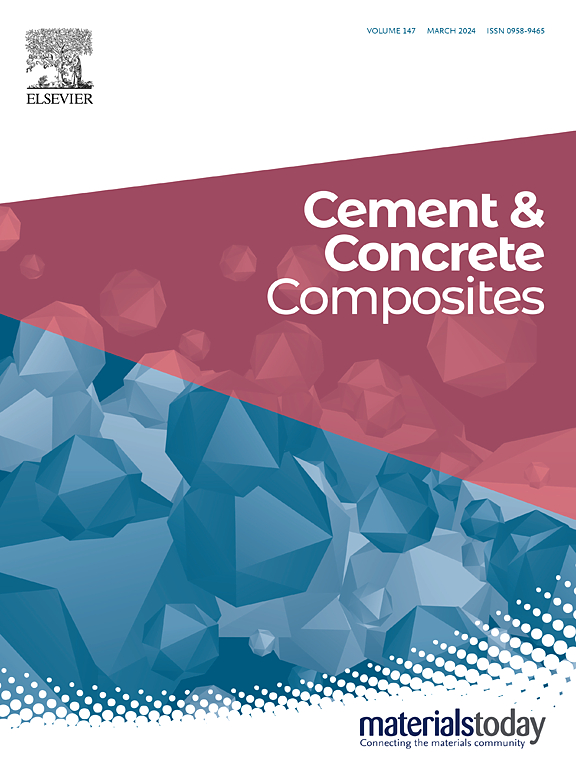探索高强工程胶凝复合材料解决超高性能混凝土结构强度-延性困境的创新策略
IF 13.1
1区 工程技术
Q1 CONSTRUCTION & BUILDING TECHNOLOGY
引用次数: 0
摘要
超高性能混凝土具有较高的抗压和抗拉强度,可以显著提高超高性能混凝土结构的承载能力。然而,由于超高压混凝土结构的应变能力明显低于钢筋,其变形能力甚至远低于常规钢筋混凝土结构,导致这类结构面临强度-延性困境。高强工程胶凝复合材料(HS-ECC)结合了ECC优异的抗拉性能(特别是抗拉应变能力)和UHPC的抗压性能,可以在整个加载过程中与钢筋协同工作,防止裂缝局部化。这提高了HS-ECC结构的承载能力和变形能力。在本研究中,HS-ECC梁的延性和承载能力优于配筋率在3.6%以内的UHPC梁。当配筋率为1.3%时,HS-ECC的延性指数超过UHPC的402.5%。进一步提出了基于分层截面法的理论模型,准确预测了HS-ECC梁的荷载-跨中挠度曲线。分析表明,随着配筋率的增加,HS-ECC对HS-ECC梁抗弯强度的贡献显著降低。随着配筋率的增加,HS-ECC抗拉应变能力要求降低,而HS-ECC抗压应变能力要求升高。最后,提出了一种以压缩区深度为指标的基于性能的设计方法,可以平衡HS-ECC梁的强度和延性,提高HS-ECC梁的利用率。本研究为钢筋HS-ECC梁的设计和实际应用奠定了基础。本文章由计算机程序翻译,如有差异,请以英文原文为准。
An innovative strategy of exploring high-strength engineered cementitious composites to solve the strength-ductility dilemma of UHPC structures
Ultra-high-performance concrete (UHPC) featuring high compressive and tensile strength could significantly enhance the load capacity of UHPC structures. However, due to the apparently inferior strain capacity of UHPC compared to that of steel bar, the deformation capacity of UHPC structures is substantially lower even than that of conventional reinforced concrete structures, leading to a strength-ductility dilemma for these kinds of structures. High-strength engineered cementitious composite (HS-ECC), combining the excellent tensile behavior of ECC (especially the tensile strain capacity) and the compressive performance of UHPC, could work compatibly with steel bars for the whole loading process preventing crack localization. This enhances both load and deformation capacity of HS-ECC structure. HS-ECC beams exhibited superior ductility and load capacity than those of UHPC beams with reinforcement ratio within 3.6 % in this research. When the reinforcement ratio was 1.3 %, the ductility index of HS-ECC exceeded that of UHPC 402.5 %. A theoretical model based on the layered section method was further proposed, accurately predicting the load-midspan deflection curves of HS-ECC beams. Analysis revealed that the contribution of HS-ECC to flexural strength of HS-ECC beams decreased significantly with increasing reinforcement ratio. The requirement of HS-ECC tensile strain capacity decreased, while the requirement of HS-ECC compressive strain capacity increased with increasing reinforcement ratio. Finally, a performance-based design method considering the compressive-zone depth as the indicator was proposed, which can balance the strength and ductility of HS-ECC beams, as well as increase the utilization ratio of HS-ECC. This research lay the ground for the design and practical application of reinforced HS-ECC beam.
求助全文
通过发布文献求助,成功后即可免费获取论文全文。
去求助
来源期刊

Cement & concrete composites
工程技术-材料科学:复合
CiteScore
18.70
自引率
11.40%
发文量
459
审稿时长
65 days
期刊介绍:
Cement & concrete composites focuses on advancements in cement-concrete composite technology and the production, use, and performance of cement-based construction materials. It covers a wide range of materials, including fiber-reinforced composites, polymer composites, ferrocement, and those incorporating special aggregates or waste materials. Major themes include microstructure, material properties, testing, durability, mechanics, modeling, design, fabrication, and practical applications. The journal welcomes papers on structural behavior, field studies, repair and maintenance, serviceability, and sustainability. It aims to enhance understanding, provide a platform for unconventional materials, promote low-cost energy-saving materials, and bridge the gap between materials science, engineering, and construction. Special issues on emerging topics are also published to encourage collaboration between materials scientists, engineers, designers, and fabricators.
 求助内容:
求助内容: 应助结果提醒方式:
应助结果提醒方式:


